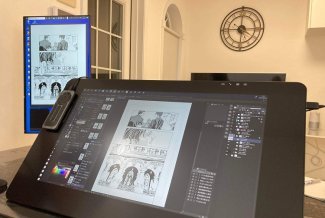Imagine, if you will, a day not too far in the future.
You and your colleagues, all fully paid-up trade union members, have just left a strategy meeting.
As far as the authorities are concerned you’re a “militant trade union wrecker” because of your ongoing campaign calling for a strike ballot at your industrial workplace.
For months all your telecommunications – your emails, your mobile phone calls – have been intercepted and monitored. In the eyes and ears of the eavesdroppers and security forces you’ve established “a pattern of behaviour”. You are guilty of “economic sabotage”.
You walk to your car, where your wife and infant daughter are waiting to take you home. A tiny unmanned aerial vehicle drones overhead. It moves in for the kill.
As you open the car door the drone, operated some distance away by a controller in a deep underground bunker, fires an explosive charge. You and your family, hitherto referred to as “collateral damage”, are obliterated. Another “trade union militant”, another “enemy of the state” has been taken out.
Fanciful dystopian future? Try asking an innocent farmer or villager in the Federally Administered Tribal Areas of North-West Pakistan the question.
Or the survivors of a drone strike on a public bus in Yemen.
“Targeted killings and drone strikes in non-war zones, for example in Pakistan and Yemen, is unlawful. It violates international law and human rights. It’s like the death penalty without trial,” says Catherine Gilfedder, a solicitor with the human rights charity Reprieve.
Catherine Gilfedder, Reprieve
Founded by campaigning lawyer Clive Stafford Smith, Reprieve is perhaps best known for its work with US prisoners on death row and detainees at Guantanamo Bay.
Catherine specialises in corporate involvement in the “war on terror” and is a member of Reprieve’s “Abuses in Counter-Terrorism” programme.
“Any male between the ages of 16 and 65 is considered to be a militant unless posthumously shown not to have been involved in fighting,” she told Equal Times in an interview at Reprieve’s London offices in July.
“The civilian impact is extensive. In any village there can be as many as six drones circling above. People are afraid to go outside or gather in groups. They are afraid to gather at funerals or in “jirgas” (village meetings).
Reprieve has two major concentrations of concern regarding drones, says Catherine.
Firstly, the legal charity believes the United States is using drones in violation of international law. And what happens if the world’s hyper-power is able to “expand” the boundaries of international law?
Secondly, there appears to be a huge proliferation in drones, with both Britain and Germany, for example, already deeply involved with their own military drones programmes.
Other “aggressive” states are also in the process of developing or acquiring drone technology.
“If we can’t stop the US violating international law, then it will also be extremely difficult to enforce international law against these other countries too,” Catherine says.
Monitoring activists
Perhaps most worrying of all for international trade unionists – and other activists monitoring and fighting the abuses of corporate and state power – is the increasing use of so-called “signature strikes”; meaning individuals or groups are targeted on the basis of a “pattern of activity”, one embracing “suspicious” phone calls, email traffic, data gathering, vehicle movement.
For it is here that the rules of law become truly blurred; where “patterns of activity” can be manipulated and interpreted to fit a proscribed and fatal outcome.
And with the recent revelations by former CIA employee Edward Snowden that the US government has been involved in the illegal mass data-mining of phone records and internet traffic of ordinary civilians, the dystopian future of “Minority Report” – where people are pre-judged, arrested and executed for what “they might be about to do” and not for any crime they have actually committed – becomes ever more real and prescient.
As Snowden’s whistleblowing has shown, dragnet surveillance is no longer theoretical.
Somewhat remarkably, given the present abuse and ever-growing threat to human rights posed by the “War of the Drones”, few national or international trade unions appear to be that concerned about the sanguinary ramifications – even unions whose very own members are involved directly or indirectly in the manufacture and maintenance of the dreaded killing machines.
“Drones are just another obscenity,” says Gino Strada, a 65-year-old Italian surgeon, who set up and runs a hospital NGO called Emergency that operates 47 healthcare centres in Afghanistan, Iraq and Sudan.
“We’re seeing increasing numbers of victims, at least 40 per cent of them children. It’s an obscenity, particularly if you think that thousands of miles away someone is putting down a killing list.
“I mean President Obama, the winner of the Nobel Peace Prize, is personally signing a killing list.
“They have squads of assassins, professional assassins, who kill people. Is this the idea of justice of the new millennium, that someone gets killed because someone else decided this one deserves to be killed without a trial, without pause, without nothing?
“Just crazy, crazy. It’s another human way to wage war. It’s not a human one, but this one is particularly nasty and particularly cruel.”
The civilian drones
Armed unmanned aerial vehicles (UAVs) commonly referred to as drones, have been in use since 1999. The remotely piloted aircraft are controlled from the ground using satellite systems and onboard cameras.
The MQ-9 “Reaper” drone, for example, has a maximum speed of 480-kms per hour (300-miles) and can carry a payload of 1,700-kilos of weaponry, including Hellfire missiles and 500-lb laser-guided bombs.
And now the era of the civilian drone is fast upon us.
Earlier this year President Obama approved legislation making it easier for the US Federal Aviation Administration to begin testing UAVs. It’s estimated that the first “civilian” drones will be airborne by the end of 2015 and that by the end of the decade around 30,000 civilian drones will be flying over the U.S.
In Britain it’s already legal to fly your own drone without permission as long as it weighs less than 20kg and is not flown within 150 metres of a congested area.
Larger drones would require approval from the Civil Aviation Authority. But the Home Office has already given permission for police forces to use drones in “appropriate” circumstances.
Chris Cole, who runs the Drone Wars UK website, remains a firm sceptic.
He says: “The U.K. is already one of the most surveyed societies in the world. Drones will quickly bring that level of surveillance right into our homes and gardens.
“Local councils, police and security agencies, private companies and even our next-door neighbours will soon be able to pilot small unmanned drones over our homes in the near future unless we put in place regulations now to protect our privacy and civil liberties.”
Today’s trade union activist, tomorrow’s “collateral damage”.
Perhaps it’s time we all wake up to the surveillance society and undeclared “War of the Drones”.









